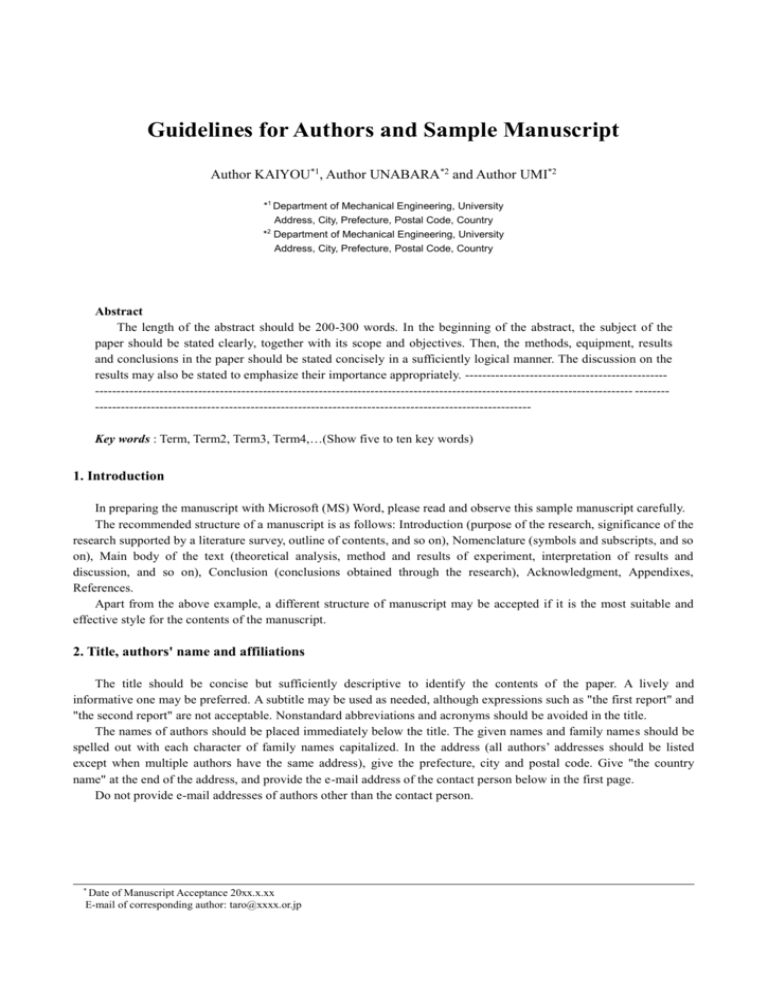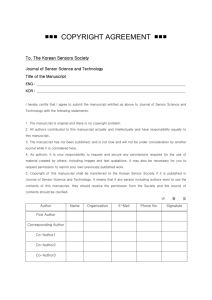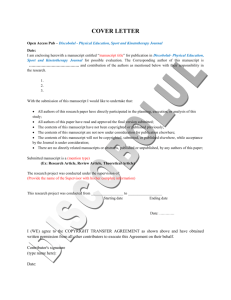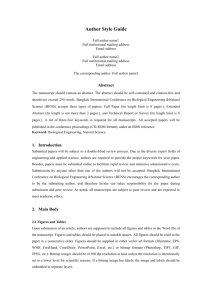Journal_Template
advertisement

Guidelines for Authors and Sample Manuscript Author KAIYOU*1, Author UNABARA*2 and Author UMI*2 *1 Department of Mechanical Engineering, University Address, City, Prefecture, Postal Code, Country *2 Department of Mechanical Engineering, University Address, City, Prefecture, Postal Code, Country Abstract The length of the abstract should be 200-300 words. In the beginning of the abstract, the subject of the paper should be stated clearly, together with its scope and objectives. Then, the methods, equipment, results and conclusions in the paper should be stated concisely in a sufficiently logical manner. The discussion on the results may also be stated to emphasize their importance appropriately. --------------------------------------------------------------------------------------------------------------------------------------------------------------------------- -----------------------------------------------------------------------------------------------------------Key words : Term, Term2, Term3, Term4,…(Show five to ten key words) 1. Introduction In preparing the manuscript with Microsoft (MS) Word, please read and observe this sample manuscript carefully. The recommended structure of a manuscript is as follows: Introduction (purpose of the research, significance of the research supported by a literature survey, outline of contents, and so on), Nomenclature (symbols and subscripts, and so on), Main body of the text (theoretical analysis, method and results of experiment, interpretation of results and discussion, and so on), Conclusion (conclusions obtained through the research), Acknowledgment, Appendixes, References. Apart from the above example, a different structure of manuscript may be accepted if it is the most suitable and effective style for the contents of the manuscript. 2. Title, authors' name and affiliations The title should be concise but sufficiently descriptive to identify the contents of the paper. A lively and informative one may be preferred. A subtitle may be used as needed, although expressions such as "the first report" and "the second report" are not acceptable. Nonstandard abbreviations and acronyms should be avoided in the title. The names of authors should be placed immediately below the title. The given names and family names should be spelled out with each character of family names capitalized. In the address (all authors’ addresses should be listed except when multiple authors have the same address), give the prefecture, city and postal code. Give "the country name" at the end of the address, and provide the e-mail address of the contact person below in the first page. Do not provide e-mail addresses of authors other than the contact person. * Date of Manuscript Acceptance 20xx.x.xx E-mail of corresponding author: taro@xxxx.or.jp 3. Headings The main body of the text should be suitably divided into sections (and if necessarily subsections), each with a heading. For instance, 4. Compensation of flow disturbance using estimated signal 4.1 Estimation of flow disturbance 4.1.1 Axisymmetric disturbance 5. Abstract Title and abstract are the keys to your work. The length of the abstract should be 200-300 words. The abstract should appear immediately following the title, authors' names and affiliations. In the abstract, the authors should clearly state the contents of the manuscript so that readers can understand the contents of the paper without reading the main body. Authors should carefully prepare the abstract, referring to the following instruction: In the beginning of the abstract, the subject of the paper should be stated clearly, together with its scope and objectives. Then, the methods, equipment, results and conclusions in the paper should be stated concisely in a sufficiently logical manner. The discussion on the results may also be stated to emphasize their importance appropriately. A summary leading to conclusions is not required. Figures, tables and references in the text should not be cited. If the citation of an equation is unavoidable, the full equation should be given rather than citing only the equation number. Do not insert line feeds in the abstract, i.e., the abstract should be written as only one paragraph. 6. Keywords Five to ten keywords should be given below the abstract. The keywords should be chosen so that they would best describe the contents of the paper. They are also useful in the classification and search of papers. The use of hyphens, prepositions and articles should be avoided. Capitalize the initial letter of each word. 7. Figures, tables, photographs Figures, photographs and tables can be used to describe clearly and accurately the contents of the paper. In general, figures are useful for presenting general tendencies, and tables are suitable for presenting specific numeric values and data. Figures, photographs and tables are printed in grayscale. Figures and tables should be presented with sufficiently informative captions. Every caption should be complete and intelligible by itself without references to the text. See an example shown below. When figures from other papers are reprinted, the permission of the original authors is required. Table 1 Examples of writing numbers. Recommended 0.567 3.141 6 3.141 6×10.5 3.141 6×106 1000 Not recommended .567 3.141,6 3.141 6・10.5 3.141 6E+6 1,000 Fig. 1 Numerical model of wave energy converter. 8. Citation of equations, references, tables, figures and others in the text At the beginning of a sentence, "Equation" and "Figure" should not be abbreviated. Within a sentence, an equation is cited with the number and "Eq." for example, "Eq. (1)," and at the beginning of a sentence, it should be written out as "Equation (1)." Within a sentence, a figure should be cited with "Fig.," for example, "Fig. 1," and at the beginning of a sentence, it should be written out as "Figure 1." N d x 1 d mi i 2 d t i 1 C t 2 d y i dt 2 2 d z N i X i d xi Yi d y i Z i d z i d t i 1 1 N Ci t N i 1 (1) (2) pv p sat 1 ζ uv uint n 2.13204 2 p sat ζ 2 RTint (3) u uint n Tv Tint 0.44675 v Tint 2RTint (4) Italic type must be used for physical and mathematical symbols. Upright Roman type may be used for differentiation operator d as shown in Eq. (1). 9. References Citations in the text are indicated by author’s last name and year with the list of references arranged in alphabetic order: for example, (Kaiyou and Umi, 2000) or the book by Kaiyou and Umi (2000). For a reference from three or more authors, the citation in the text is indicated by the first author's name followed by "et al." and the year: for example, (Kaiyou, et al., 2000). More than one reference from the same author(s) in the same year are identified by the letters "a", "b", "c", placed after the year: for example, (Kaiyou and Unabara 2000a, 2000b). Unpublished works (including papers not yet submitted or not yet published) should be avoided. The complete name of the journal referred to should be given. Cite references published as recently as possible. If a reference is not written in English, authors are required to translate the title into English and indicate the original language as "(in Japanese)," for example. See an example below. References Kaiyou, T. and Unabara, J., Title, Transactions, Vol.10, No.1 (2000), pp.10-20. Kaiyou, T, Unabara, H. and Umi, H., Numerical and Experimental Analysis of Wave Energy Converter in Regular Waves, Transactions of Engineers of Japan, Vol.1, No.1 (2000), pp.10–20 (in Japanese). Kaiyou, T. and Unabara, H., Development of Floating Type Wave Energy Converter, Proceedings of the 10th International Conference on Engineering (2001), Paper No. 1234.






